#St. Michael´s Mount
Text
Mit dem Schnee kommt der Tod von Nicola Upson
“Mit dem Schnee kommt der Tod” ist schon der neunte von insgesamt elf Teilen der Josephine Tey und Archie Penrose-Reihe und wie es für die Jahreszeit gehört, ist es ein Weihnachtskrimi. Ich kenne keinen der anderen Teile und hatte die Befürchtung, dass mir Informationen fehlen. Das war aber nicht der Fall.
Weihnachten 1920: Archie und Josephine wurden von Archies langjähriger Freundin Hilaria…

View On WordPress
#Josephine Tey und Archie Penrose#Marlene Dietrich#Mit dem Schnee kommt der Tod#Nicola Upson#St. Michael´s Mount
0 notes
Text
Cornwall 2024 - Tag 21
Ladies and Gentlemen!
Für den Besuch des St. Michael´s Mount buchten wir insgesamt 3 Termine bzw. Zeitfenster. Denn wir wussten ja nicht, wie das Wetter sich entwickeln wird und wer will schon im strömenden Regen oder bei starkem Wind hier herum tapern - wir jedenfalls nicht.

Dank unserer Mitgliedschaft beim National Trust können wir hier sehr großzügig verfahren, denn der Besuch dieser Hauptsehenswürdigkeit Cornwalls wird ebenfalls davon abgedeckt.

Es handelt sich um eine Insel, die nicht weit von der Küste entfernt liegt, gerade einmal 300×300 Meter groß. Ein Hügel, ein Kloster und ein gepflasterter Weg, den man bei Ebbe auch zu Fuß benutzen kann.

Über Jahrhunderte hat eine Gemeinschaft dort eine Klosteranlage mit Hafen und kleinem Städtchen gebaut und einen unglaublichen
Garten angelegt.

Die Insel hat eine lange Geschichte, die bis in die prähistorische Zeit zurückreicht, aber ihre Berühmtheit verdankt sie vor allem der mittelalterlichen Benediktinerabtei und dem Schloss, das auf ihrem Gipfel thront.

Wir sind nicht etwa in der Normandie, am Kloster Mont-Saint-Michel, sondern in Cornwall am Sankt Michael’s Mount.
Die Ähnlichkeiten zwischen Mont-Saint-Michel und Sankt Michael’s Mount sind nicht zufällig, denn Mont-St-Michel heißt auf Französisch nichts anderes als St. Michaels Mount. Auch optisch sehen sich die beiden Inseln irgendwie sehr ähnlich.

Eine kleine Gemeinschaft von Mönchen aus Mont-Saint-Michel in der Normandie ließ sich hier nämlich ebenfalls nieder und die Architektur auf der Insel wurde tatsächlich vom französischen Vorbild inspiriert. Dies war der Ursprung des Namens „Sankt Michael’s Mount“.
Im Jahr 495 n. Chr. soll St. Keyne hier eine Kapelle errichtet haben, aber die eigentliche monastische Siedlung entstand dann im 8ten Jahrhundert.

Die Gemeinschaft der Mönche, die sich niederließen, verehrte den Erzengel Michael und der Berg wurde zu einem wichtigen Wallfahrtsort. Im Laufe der Jahre wechselten die Besitzer der Insel und sie wurde zu verschiedenen Zeiten von Klöstern und Königen kontrolliert.

Im 12. Jahrhundert wurde auf der Insel eine Abtei im normannischen Stil errichtet, die dem Erzengel Michael gewidmet war. Die Abtei diente als Pilgerstätte und wurde im Laufe der Jahrhunderte weiter ausgebaut. Die heutige Burg, die im 14. Jahrhundert hinzugefügt wurde, ist ein beeindruckendes Bauwerk, das auf dem Gipfel der Insel thront.

Die Insel ist bei Ebbe über einen Damm erreichbar, der bei Flut jedoch überspült wird, wodurch sie zu einer echten Insel wird. Dieser natürliche Damm und die Gezeiten machten die Insel zu einem leicht zu verteidigendem Ort.

Während der "Reformation" im 16. Jahrhundert unter Heinrich VIII. musste die Abtei aufgegeben werden, und im Jahr 1659 kaufte Sir John St. Aubyn die Insel.
Sankt Michael’s Mount hat im Laufe der Jahrhunderte viele Veränderungen erlebt, darunter Belagerungen während des Bürgerkriegs im 17. Jahrhundert, aber es hat seine beeindruckende Präsenz und seinen historischen Charme bewahrt.

Die Insel mit Burg hat auch einen gewissen Joachim von Ribbentrop (1893-1946) begeistert. Ribbentrop war von 1936 bis 1938 Botschafter des Deutschen Reichs in London. In diesen Jahren hatte er eine besondere Vorliebe für Cornwall entwickelt und für St Michael’s Mount insbesondere.

Großspurig und arrogant ließ er bei einem seiner Besuche in Cornwall, nicht lange vor Ausbruch des Zweiten Weltkrieges, die Gastgeber wissen, dass er beabsichtige seinen Wohnsitz nach St Michael’s Mount zu verlegen, denn Hitler hätte ihm nach der Eroberung Großbritanniens für seine Loyalität Cornwall versprochen.

Wie wir wissen kam es anders und St Michael’s Mount gehört seit 1954 dem National Trust. Die ehemaligen Eigentümer, die Familie des gegenwärtigen 5. Barons St Levan of St Michael’s Mount, James Piers Southwell St Aubyn, wohnen aber immer noch auf der Insel, zusammen mit dreißig weiteren ständigen Bewohnern.

Die Felsformation mit dazugehörender Burg ist schon sehr imposant, leider aber auch in der Reisehauptsaison total überlaufen. Während der Ebbe kann man sie trockenen Fußes erreichen, sonst nur mit dem Boot.
Der Besuch muss deshalb sehr gut geplant werden. Tickets sollte man unbedingt vorher buchen und nicht vergessen, dass man - je nach Tide - auch den Bootstransfer buchen muss.

Man kann die Insel nur zu Fuß erreichen, wenn Ebbe herrscht, denn es ist eine Gezeiteninsel. Wer zu Fuß hinüber möchte, der muss eben darauf warten, bis sich das Wasser zurückzieht.
Aber dann muss man auch nicht durch das schlammige, matschige Wattenmeer spazieren. Es gibt einen befestigten Weg aus groben Steinpflaster, auf dem man ganz bequem und trockenen Fußes zur Insel gelangt. Bei Flut ist von diesem Weg natürlich nichts zu sehen.

Wir waren stellenweise fassungslos wie unvorbereitet viele Besucher hier aufschlagen und weder ein Ticket besitzen noch die Gezeiten oder Öffnungszeiten im Blick haben.
Viele laufen einfach rüber und werden dann entweder abgewiesen und wenn es ganz Dicke kommt, zusätzlich noch von der schnell ansteigenden Flut überrascht.

Jedes Mal, wenn wir hier vorbei kamen, sahen wir schon von weitem, wie sich Menschen durch das Wasser kämpften. Teilweise nur kniehoch, manchmal aber auch schon hüfthoch. Viele davon hatten noch Kinder dabei. Unfassbar!

Wir starten am Strand, reihen uns in die Menge der Menschen ein, die über den Causeway hinüber läuft. Auf der Insel angekommen, werden wir sofort nach Tickets gefragt und - nachdem das bejaht wurde - einem Mitarbeiter des National Trusts zugewiesen. Dieser scannt unsere Ticket Codes und ebenfalls unsere Mitgliedschaft im National Trust.

So dürfen wir schon an all denen vorbei gehen, die gleich am Tor abgefangen wurden, weil sie vielleicht gar keine Tickets oder erst für ein späteres Zeitfenster Tickets gekauft haben.
Mit unserer National Trusts Karte sparen wir zwar die 26 £ (ca. 30 €) pro Person Eintritt, mussten aber dennoch Tickets für einen Timeslot buchen.

Auf der Insel angekommen sieht man rechter Hand eine Häuserreihe. Eines dieser kleinen Häuser ist an der Seite mit einem schönen Gemälde verziert. Es zeigt diesen englischen Küstenabschnitt inklusive Insel und Segelschiffen in historischer Form.
Bei unserem ersten Besuch halten wir uns linker Hand, am Friedhof vorbei, in Richtung des Gartens. Eine große Wiese empfängt uns, hier kann man ausruhen, spielen, Picknick machen, was die Briten auch mit Begeisterung tun.

An einem Kontrollpunkt werden erneut die Eintrittskarten, dieses Mal für den Garten, geprüft. Erst wissen wir gar nicht, wo denn der Garten sein soll, denn wir sind schon irgendwie am Ende der Insel angekommen und die Burg liegt unmittelbar vor uns – nur eben sehr hoch oben.
Nach wenigen Metern begreifen wir es dann auch: Der Garten ist steil, extrem steil, in den Hang gebaut.

Die Burg überragt die Insel und ist umgeben von tollen Gärten, die sich den steilen Hang hinauf ziehen. Der Walled Garden wurde etwa im Jahr 1780 angelegt.
Wie das mit Felsen nun einmal so ist, nisten sich in ihren Spalten gern unerwünschte Unkräuter ein.

Zum Aufgabenbereich der St Michael’s Mount-Gärtner gehört also auch die Beseitigung von Unkraut an den bis zu sechzig Meter hohen Felswänden.
Wer nicht schwindelfrei ist und unter Höhenangst leidet, sollte sich besser nicht auf diesen Job bewerben.

Unser 2ter Besuch verlief in ähnlicher Reihenfolge ab, nur dass wir nach der Eingangskontrolle rechts herum gehen.
Bevor es jedoch hoch zur Burg geht, muss noch ein weiterer Kontrollposten des National Trusts bewältigt werden.

Hier werden ebenfalls noch einmal die Tickets kontrolliert, dieses Mal auf die Berechtigung zum Zugang zur Burg.
Danach steht dem steilen Aufstieg zur Inselspitze nichts mehr im Wege und so macht sich bereits am frühen Morgen eine Menschen-Karawane auf den Weg in die Höhe.

Oben angekommen ist der Blick in die Ferne, über das Meer, schon ziemlich sensationell.
Anschließend geht es über sehr ausgetretene Treppen, an denen der Zahn der Zeit stark nagt, in das Innere des Castles.

Dort werden die Besucher zu Gruppen von etwa 15 Personen zusammen gefasst, bevor es von Raum zu Raum geht.
In jedem Raum steht ein weiterer Mitarbeiter des National Trusts, der sicherstellt, dass sich alle Besucher regelkonform benehmen.

Auf Fragen, die Interessierte stellen, wird gerne umfassend und kompetent geantwortet.
Fotografieren ist erlaubt, allerdings ist es schon schwierig um die ganzen Menschen drumherum zu knipsen.

Für den reinen Besuch der Burg muss man ungefähr 1 Stunde Zeit veranschlagen. Dazu kommen Aufstieg, Abstieg und natürlich der Weg zu Insel überhaupt.
Wer alles zusammen an einem Tag erkunden möchte, muss mit mindestens 3 Stunden Zeitaufwand rechnen. Kommen noch ein Cream Tea oder gar Afternoon Tea hinzu, wird man mit der Zeitspanne des Niedrigwassers nicht hinkommen und benötigt noch einen Bootstransfer (£ 2,80) zusätzlich.

Alles in Allem lohnt sich alleine schon hier der Touring Pass des National Trusts.
Good Night!
Angie, Micha und Mister Bunnybear (Hasenbär)
7 notes
·
View notes
Text

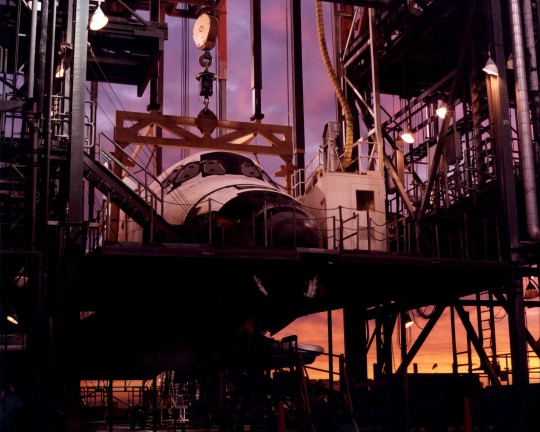


"STS-92 Discovery at the Mate-Demate Device
The early-morning sun provides a golden backdrop to the Space Shuttle Discovery encased in the Mate-Demate Device (MDD) at NASA's Dryden Flight Research Center at Edwards, CA. The gantry-like MDD structure is used to prepare the shuttle for its ferry flight back to the Kennedy Space Center in Florida, including mounting the shuttle atop NASA's modified Boeing 747 Shuttle Carrier Aircraft.

Shuttle Crew: Commander Brian Duffy; Pilot Pamela A. Melroy; and Mission Specialists Koichi Wakata, Leroy Chiao, Peter J. K. Wisoff, Michael Lopez-Alegria, and William S. McArthur."
Photographed by Carla Thomas.
Date: October 29, 2000
NASA ID: EC00-0311-7, EC00-0311-8, EC00-0311-9, EC00-0311-10, EC00-0311-11
#STS-92#Space Shuttle#Space Shuttle Discovery#Discovery#OV-103#Orbiter#NASA#Space Shuttle Program#Mate-Demate Device#MDD#Dryden Flight Research Center#Edwards Air Force Base#California#October#2000#my post
24 notes
·
View notes
Text
"Little Women" Posthumous Reunion: Final Resting Places of the People Behind the Novel and Its Adaptations
As a fan of the YouTube channel Hollywood Graveyard and the "Posthumous Reunion" pages on FindAGrave.com, I thought I would make a similar tribute to the people behind Little Women and its best-known screen adaptations. This is a guide to the burial sites (if they exist) of all the adaptations' leading actors and creative team members who have died, as well as those of the Alcott family and their friends, for anyone who hopes to visit them someday.
@littlewomenpodcast, @joandfriedrich, @thatscarletflycatcher
Arlington National Cemetery – Arlington, Virginia, USA
John Davis Lodge (John Brooke, 1933 film)
Cementerio de Benalmádena – Benalmádena, Spain
Paul Lukas (Friedrich Bhaer, 1933 film)
Ceder Hill Cemetery – Hartford, Connecticut, USA
Katharine Hepburn (Jo, 1933 film)
Cimitero Flaminio – Rome, Italy
Rossano Brazzi (Friedrich Bhaer, 1949 film)
Cimitiére Communal de Montrouge – Montrouge, France
May Alcott Nieriker (real-life Amy) (site unknown)
Forest Lawn Memorial Park, Glendale – Glendale, California, USA
Edna May Oliver (Aunt March, 1933 film)
June Allyson (Jo, 1949 film)
Elizabeth Taylor (Amy, 1949 film)
Robert Young (Mr. Laurence, 1978 miniseries)
George Cukor (director, 1933 film)
Mervyn LeRoy (director/producer, 1949 film)
Max Steiner (music, 1933 and 1949 films)
Adolph Deutsch (music, 1949 film)
Forest Lawn Memorial Park, Hollywood Hills – Los Angeles, California, USA
Jean Parker (Beth, 1933 film)
Leon Ames (Mr. March, 1949 film)
Holy Cross Cemetery – Culver City, California, USA
Mary Astor (Marmee, 1949 film)
Inglewood Park Cemetery – Inglewood, California, USA
Samuel S. Hinds (Mr. March, 1933 film)
Kensico Cemetery – Valhalla, New York, USA
Henry Stephenson (Mr. Laurence, 1933 film)
Mortlake Crematorium – Richmond, Greater London, England
Pat Nye (Hannah, 1970 miniseries)
Mount Hope Cemetery – Hastings-on-Hudson, New York, USA
Lucile Watson (Aunt March, 1949 film)
Oak Hill Cemetery – Lawrence, Kansas, USA
Alf Whitman (real-life Laurie)
Pleasant View Cemetery – Lyme, Connecticut, USA
Joan Bennett (Amy, 1933 film)
Savannah Cemetery – Savannah, Tennessee, USA
Elizabeth Patterson (Hannah, 1949 film)
Shiloh Cemetery – Shiloh, Illinois, USA
Mary Wickes (Aunt March, 1994 film)
Sleepy Hollow Cemetery – Concord, Massachusetts, USA
Louisa May Alcott (author and real-life Jo)
Abigail May Alcott (real-life Marmee)
Amos Bronson Alcott (real-life Mr. March)
Anna Alcott Pratt (real-life Meg)
John Bridge Pratt (real-life John Brooke)
Elizabeth Sewall Alcott (real-life Beth)
Henry David Thoreau (possible real-life Friedrich Bhaer)
Sparkman Hillcrest Memorial Park – Dallas, Texas, USA
Greer Garson (Aunt March, 1978 miniseries)
St. Leonard’s Churchyard – Hove, East Sussex, England
C. Aubrey Smith (Mr. Laurence, 1949 film)
Valhalla Memorial Park – North Hollywood, California, USA
Mabel Colcord (Hannah, 1933 film)
Westwood Village Memorial Park – Los Angeles, California, USA
Janet Leigh (Meg, 1949 film)
Cremated, Ashes Held Privately or Scattered
Frances Dee (Meg, 1933 film)
Douglass Montgomery (Laurie, 1933 film)
Peter Lawford (Laurie, 1949 film)
Patrick Troughton (Mr. March, 1970 miniseries)
Jean Anderson (Aunt March, 1970 miniseries)
Dorothy McGuire (Marmee, 1978 miniseries)
Richard Gilliland (Laurie, 1978 miniseries)
William Schallert (Mr. March, 1978 miniseries)
Virginia Gregg (Hannah, 1978 miniseries)
Angela Lansbury (Aunt March, 2017 miniseries)
Michael Gambon (Mr. Laurence, 2017 miniseries)
Sarah Y. Mason (screenwriter, 1933 and 1949 films)
Victor Heerman (screenwriter, 1933 and 1949 films)
Merian C. Cooper (producer, 1933 film)
Donated to Medical Science
Spring Byington (Marmee, 1933 film)
Unknown (Not Made Public or No Information Online)
Ladislas Wisniewski (real-life Laurie)
Richard Stapley (John Brooke, 1949 film)
Stephanie Bidmead (Marmee, 1970 miniseries)
Frederick Jaeger (Friedrich Bhaer, 1970 miniseries)
John Welsh (Mr. Laurence, 1970 miniseries)
John Neville (Mr. Laurence, 1994 film)
David Hempstead (screenwriter, 1933 film)
Elmer Bernstein (music, 1978 miniseries)
#little women#find a grave#actors#actresses#creative team#louisa may alcott#alcott family#graves#burial#cremation#tw: death
6 notes
·
View notes
Text

Sea Vixen FAW.2's of 892 NAS overfly St. Michael's Mount, Mount's Bay, Cornwall in 1968
credit Mark Taylor
@CcibChris via X

6 notes
·
View notes
Text

Larry Hama brings back the Original G. I. Joe (and the very fetching G. I. Jane as well) in Marvel’s G. I. Joe #86 to commemorate 25 Years of G. I. Joe, and he showed respect to both characters in the story when Cobra Command mounts a raid on a secret Strategic Defense Initiative set in the Chrysler Building, with the hoped for bonus of framing Destro’s Iron Grenadiers in the process as well.
Larry Hama definitely did not make General Joe Colton’s Jane’s appearances token cameos by any means. Instead he wrote it with having Joe be the one who both planned a way to retake the initiative as well as deduce Cobra’s real operation.
Its too bad Larry didn’t have Gen. Colton lead the 1980s Team from the start. As good as Hawk is, Joe was a Green Beret and used to unconventional warfare (a trait Joe Casey demonstrated as well in DDP’s G. I. Joe: America’s Elite’s Phoenix Guard arc).
And as always, Larry added real life elements to this story such as the US military transitioning to the Beretta from the M1911A1, as well as the SDI project- a controversial subject in the 1980s.
(Jane’s explanation of the basics on how the system works with the laser bounced off a series of satellites was one option (also discussed in Payne Harrison’s novel Storming Intrepid). Granted its reminiscent of both the Gamilon Reflex Cannon in Starblazers and the base principle for the Robotech Defense Force Grand Cannon based in Alaska over at Macross, but sound nonetheless). Again Larry shows the importance of doing research for his G. I. Joe tales.
SDI of course was also the subject for Tom Clancy’s The Cardinal of the Kremlin and was a variation of it was presented in Dale Brown’s Silver Tower via Lt. Gen. St. Michael’s Armstrong Space Station.
Of course, G. I. Joe #86 wouldn’t be a oneshot return for General Colton & G. I. Jane; both would return in G. I. Joe #s 127, and 151, as well as in G. I. Joe Frontline #s 1, 2, & 4. And General Colton would later be assigned to head the team for DDP’s G. I. Joe: America’s Elite by Joe Casey, with Jane close by as he commands the unit especially DDP’s World War III arc (America’s Elite #35 has one of that series’ best covers IMHO).
And of course Larry has both on hand during IDW’s G. I. Joe series as well.
If they get around to do a proper animated Joe series (Renegades was the best thus far), Peter Cullen & Jennifer Hale would be my picks to voice them; for a properly presented Live Action film, either Jonathan Frakes or Robert Downey Jr. and Laura Dern would be my choice.
1 note
·
View note
Text
It is believed that
It is believed that there is liquid water beneath the surface of Mars
Could liquid water change the climate of Mars if it enters the craters on the surface?
But today, liquid water is unstable on the planet's surface because the pressure would mean it would boil away, and rain would be impossible. Today, temperatures on Mars are below freezing all over the planet, and so the martian ground is frozen.2 Dec 2023
Evidence for Recent Liquid Water on Mars: Basic Features of ...
NASA Jet Propulsion Laboratory (.gov)
https://www.jpl.nasa.gov › images › pia01031-evidence...
22 Jun 2000
Water is the chief agent of weathering and erosion on Earth. Mars is a much drier, colder planet on which liquid water cannot exist very long at the surface because it will immediately begin to boil, evaporate, and freeze--all at the same time. However, new pictures from the Mars Orbiter Camera (MOC) onboard the Mars Global Surveyor (MGS) have provided an astonishing observation which suggests that liquid water may have played a role in shaping some recent gully-like features found on the slopes of various craters, troughs, and other depressions on the red planet.
These pictures introduce the basic features of a martian gully. The figure on the left is an example from Mars, the figure on the right is a gully on Earth. In the Earth picture, rain water flowing under and seeping along the base of a recently-deposited volcanic ash layer has created the gully. For Mars, water is not actually seen but is inferred from the landforms and their similarity to examples on Earth.
The landforms both on Earth and Mars are divided into three parts: the alcove, the channel, and the apron. Water seeps from between layers of rock on the wall of a cliff, crater, or other type of depression. The alcove forms above the site of seepage as water comes out of the ground and undermines the material from which it is seeping. The erosion of material at the site of seepage causes rock and debris on the slope above this area to collapse and slide downhill, creating the alcove.
The channel forms from water and debris running down the slope from the seepage area. The point where the top of the channel meets the bottom of the alcove is, in many cases, the site where seepage is occurring. Channels are probably flushed-clean of debris from time to time by large flash floods of water released from behind an ice barrier that might form at the site of seepage during more quiescent times.
The aprons are the down-slope deposits of ice and debris that were moved down the slope and through the channel. Whether any water--likely in the form of ice--persists in these deposits is unknown. The fact that the aprons do not go very far out onto the floors of craters and troughs (e.g., the foreground of the figure on the left) indicates that there is a limit as to how much water actually makes it to the bottom of the slope in liquid form. Most of the water by the time it reaches the bottom of the slope has probably either evaporated or frozen.
The MOC image on the left was acquired July 3, 1999, and is located on the south-facing wall of an impact crater near 54.8°S, 342.5°W. The MOC image is illuminated from the upper left; north is toward the upper right. The MOC image covers an area 1.3 km (0.8 mi) wide by 2 km (1.2 mi) long. The pictures from the flank of the Mount St. Helens volcano in Washington (right; large image and inset) were taken by MGSMOC Principal Investigator, Michael C. Malin, in the 1980s after the eruptions of May 1980. They are illuminated from the left; note footprints on left side of the picture for scale, also note the colored bar, which is 30 cm (11.8 in) long.
Well, on Mars, air, water, light show the right signs or will someday, but I cannot survive there
Because I cannot survive anywhere in life without my wife, my doll Sneha
So how will the microbes growing inside me survive there
Whatever happens, I am going back
Whatever happens, friends, I have written a lot about microbes
You decide whether tomorrow's world will find this article of mine as a lesson or not
Till then, allow me to run for another article
Translate Hindi
माना की मंगल ग्रह की सतह के नीचे तरल पानी है
क्या तरल पानी सतह की क्रटरों में आते ही मंगल की हवा का परिस्थिति बदल सकता है
लेकिन आज, ग्रह की सतह पर तरल पानी अस्थिर है क्योंकि दबाव का मतलब होगा कि यह उबल जाएगा, और बारिश असंभव होगी। आज, मंगल ग्रह पर तापमान पूरे ग्रह पर हिमांक से नीचे है, और इसलिए मंगल ग्रह की ज़मीन जमी हुई है।2 दिसंबर 2023
मंगल ग्रह पर हाल ही में तरल पानी के लिए साक्ष्य: ... की बुनियादी विशेषताएं
नासा जेट प्रोपल्शन प्रयोगशाला (.gov)
https://www.jpl.nasa.gov › छवियाँ › pia01031-evidence...
22 जून 2000
पानी पृथ्वी पर अपक्षय और क्षरण का मुख्य कारक है। मंगल एक बहुत ही शुष्क, ठंडा ग्रह है जिस पर तरल पानी बहुत लंबे समय तक सतह पर मौजूद नहीं रह सकता क्योंकि यह तुरंत उबलना, वाष्पित होना और जमना शुरू हो जाएगा - सभी एक ही समय में। हालांकि, मार्स ग्लोबल सर्वेयर (एमजीएस) पर लगे मार्स ऑर्बिटर कैमरा (एमओसी) की नई तस्वीरों ने एक आश्चर्यजनक अवलोकन प्रदान किया है जो बताता है कि लाल ग्रह पर विभिन्न क्रेटरों, गर्तों और अन्य अवसादों की ढलानों पर पाए गए कुछ हाल ही में बने नाले जैसी विशेषताओं को आकार देने में तरल पानी की भूमिका हो सकती है। ये तस्वीरें एक मंगल ग्रह की नाले की बुनियादी विशेषताओं का परिचय देती हैं। बाईं ओर की आकृति मंगल ग्रह का एक उदाहरण है, दाईं ओर की आकृति पृथ्वी पर एक नाला है। पृथ्वी की तस्वीर में, हाल ही में जमा ज्वालामुखीय राख की परत के नीचे बहते और रिसते बारिश के पानी ने नाले का निर्माण किया है। मंगल के लिए, पानी वास्तव में दिखाई नहीं देता है, लेकिन भूमि के रूपों और पृथ्वी पर उदाहरणों के साथ उनकी समानता से अनुमान लगाया जाता है। पृथ्वी और मंगल दोनों पर रिसाव स्थल के ऊपर एक कोना बनता है, क्योंकि पानी जमीन से बाहर आता है और उस सामग्री को कमजोर कर देता है जिससे यह रिसाव हो रहा है। रिसाव स्थल पर सामग्री के क्षरण के कारण इस क्षेत्र के ऊपर ढलान पर चट्टान और मलबा ढह जाता है और नीचे की ओर खिसक जाता है, जिससे कोना बनता है। रिसाव क्षेत्र से ढलान से नीचे की ओर बहने वाले पानी और मलबे से चैनल बनता है। वह बिंदु जहाँ चैनल का शीर्ष कोना के तल से मिलता है, कई मामलों में, वह स्थान होता है जहाँ रिसाव हो रहा होता है। चैनल संभवतः समय-समय पर बर्फ की बाधा के पीछे से छोड़े गए पानी की बड़ी बाढ़ से मलबे से साफ हो जाते हैं जो अधिक शांत समय के दौरान रिसाव स्थल पर बन सकते हैं। एप्रन बर्फ और मलबे के नीचे की ओर जमा होते हैं जिन्हें ढलान से नीचे और चैनल के माध्यम से ले जाया गया था। क्या कोई पानी - संभवतः बर्फ के रूप में - इन जमाओं में बना हुआ है, यह अज्ञात है। तथ्य यह है कि एप्रन क्रेटरों और गर्तों के फर्श पर बहुत दूर तक नहीं जाते हैं (उदाहरण के लिए, बाईं ओर की आकृति का अग्रभूमि) यह दर्शाता है कि इस बात की एक सीमा है कि तरल रूप में ढलान के नीचे वास्तव में कितना पानी पहुंचता है। ढलान के नीचे पहुंचने तक अधिकांश पानी शायद वाष्पित हो चुका होता है या जम गया होता है।
बाईं ओर की MOC छवि 3 जुलाई, 1999 को प्राप्त की गई थी, और यह 54.8°S, 342.5°W के पास एक प्रभाव क्रेटर की दक्षिण-मुखी दीवार पर स्थित है। MOC छवि ऊपरी बाएँ से प्रकाशित है; उत्तर ऊपरी दाएँ की ओर है। MOC छवि 1.3 किमी (0.8 मील) चौड़े और 2 किमी (1.2 मील) लंबे क्षेत्र को कवर करती है। वाशिंगटन में माउंट सेंट हेलेन्स ज्वालामुखी के पार्श्व भाग से ली गई तस्वीरें (दाहिनी ओर; बड़ी छवि और इनसेट) एमजीएसएमओसी के प्रधान अन्वेषक माइकल सी. मालिन द्वारा मई 1980 के विस्फोटों के बाद 1980 के दशक में ली गई थीं। उन्हें बाईं ओर से प्रकाशित किया गया है; पैमाने के लिए चित्र के बाईं ओर पैरों के निशान देखें, साथ ही रंगीन पट्टी पर भी ध्यान दें, जो 30 सेमी (11.8 इंच) लंबी है।
खैर मंगल में हवा पानी रोशनी सही संकेत प्रदर्शन करता है या कभी करेगा मगर मैं वहां जिंदा नहीं रह सकता हूँ
क्योंके मैं जीवन में मेरी बीवी मेरी गुड़िया स्नेहा के बिना कहीं भी जिंदा नहीं रह सकता हूँ
तो मेरे अंदर में पलने वाले माइक्रोब्स खाक जीएगा वहां
कैसे भी हो मैं वापस हो रहा हूँ बस
जो भी हो दोस्तों मैं काफी कुछ लिखा हूँ माइक्रोब्स को लेकर
कल की जमाने को मेरी यह लेख लेसन जैसा लगेगा की नहीं यह आप सोचिए
तब तक मुझे आज्ञा दीजिए एक और लेख के लिए दौढ़ूँ
0 notes
Text
Stürmische Weihnacht in Cornwall von Maxim Wahl
Zugegeben, das Cover und auch der Handlungsort haben mich total neugierig gemacht. Der Klappentext versprach historische Spannung mit einen Schuss Romantik. Leider war ich nicht so begeistert, wie ich es wahrscheinlich hätte sein sollen.
Die fast 100jährige Lady Virginia reist mit ihrem Enkel nach St. Michael´s Mount um das Haus, in dem sie aufgewachsen ist, noch einmal zu sehen. Während des…

View On WordPress
#NetGalleyDE#stuermischeweihnachtincornwall#Gezeiteninsel#Maxim Wahl#Savoy-Reihe#St. Michael´s Mount#Stürmische Weihnacht in Cornwall
0 notes
Text
Michael Savage New Canaan The New Era of Muscle Cars
Muscle mass autos have actually developed a great deal for many years. The days of ground pounding monsters getting 6 or 8 mpg are gone, and also a new age of muscular tissue autos, and also muscle vehicle performance components has arrived. The muscle mass automobiles nowadays are a lot more powerful, much more trustworthy, and also obtain better fuel economic climate. As well as the ones that are modded, now that's a different tale.
Michael Savage New Canaan
Back then, if you had an enriched muscle mass cars and truck, the power was unbelievable, but it had not been extremely streetable. Nowadays you can make some small alterations that will improve power significantly as well as offer you that little of extra power, without making it less streetable. Obviously there's lots of points today that can be done to the modern-day muscle cars and trucks that will certainly boost power significantly and also make them run harsh. The distinction today is that there are choices. On a lot of the muscle mass cars and trucks today, a simple cool air consumption, receiver, and also exhaust system will certainly go a long method. a minimum of 60 additional horsepower without running rough, as well as several more miles per gallon on gas economy. Which indicates you can in fact drive it. I lately met up with a turbo battery charger company below in your area that has actually an unique set up for their turbo chargers. The company is STS Turbo. The are called remote mount turbo chargers. Also described as rear mount turbo chargers. The cars and truck that I experienced this system on was a 2003 corvette Z06. The turbos entered location of the mufflers, as well as the air filters installed back by the rear tires. You then have charger pipes that bring the air back up to the intake of the engine. This corvette, running a modest boost level was attaining 580 hp at the back wheels. that was on a stock electric motor, no other alterations had actually been made to make it hold the added power.
Michael Savage New Canaan
This corvette got tons of power, and also if the electric motor were to be constructed to hold the additional power, the boost could be turned up higher as well as the car can have accomplished about 750 horse power at the rear tires, and that's with the base turbos that came with the package. Among the various other amazing points though was that the twin turbo set up included a considerable amount of fuel economic situation when it was driven conservatively. Several of the people running the sts twin turbo kits are getting mid to high 30's in the miles per gallon. A muscle mass vehicle that gets incredible gas mileage and also has crazy power. STS makes their remote place turbo sets for the Mustangs, Corvettes, Camaros, and also all the hemi cars, as well as several various other automobile applications. Times actually have changed.
0 notes
Text
Cornwall 2024 - Tag 20
Ladies und Gentlemen!
Eine Seefahrt die ist lustig,
Eine Seefahrt, die ist schön,
Denn da kann man fremde Länder
Und noch manches andre sehn.
Hol-la-hi, hol-la-ho,
Hol-la-hi-a hi-a hi-a,
Hol-la-hia, hol-la-ho,
Hol-la-hi, hol-la-ho,
Hol-la-hi-a hi-a hi-a,
Hol-la-ho ...

Heute geht es ... Richtig! ... auf´s Wasser. Bootstouren gehören zu einem Besuch in Cornwall irgendwie dazu und so hatten wir uns im Vorfeld bereits für eine spezielle Tour entschieden.

Natürlich hat es etwas mit Tieren zu tun, denn wir wollten Delfine, Vögel und andere Meerestiere sehen. Unter den vielen Anbietern, die sich hier in Penzance tummeln, fiel unsere Wahl auf den Mermaid Wildlife Trip.

Dieser Anbieter nutzt ein kleines Fischerboot für seine Touren. Fast alle anderen fahren mit diesen High Speed Booten, das ist nix für uns.

Maximal 12 bis 15 Personen sind hier nur mit an Bord - sehr angenehm. Noch viel angenehmer ist es, dass dieses Boot auch über eine Toilette verfügen.
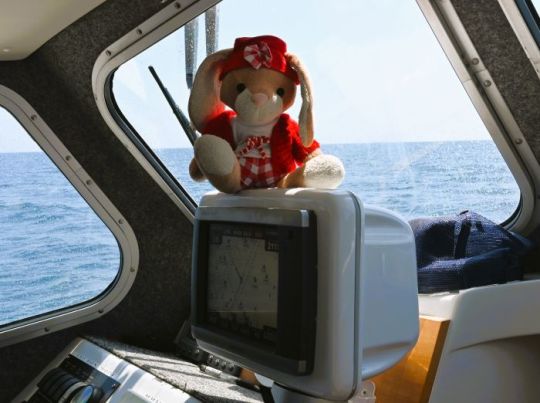
Man kann sich aussuchen, ob man auf einer der Bänke in der Mitte des Bootes oder lieber ganz hinten sitzen will.

Die Tour startet in dem schönen Hafenstädtchen Penzance und endet dort natürlich auch wieder.

Wichtig! An Bord gibt es keine Getränke oder Essen, aber wir haben alles dabei plus Tabletten gegen Seekrankheit und natürlich auch Sonnencreme & Brille.

Unsere dreistündige Tour führt von Penzance, an der Südküste in Richtung Westen entlang und natürlich um den St. Michael´s Mount, die Hauptsehenswürdigkeit dieser Gegend.

Wir genießen den Blick auf die Klippen, sehen den Hafen von Mousehole und erkennen deutlich das Freilufttheater Minack.

Unser Fischerboot tuckert gemütlich durchs Wasser, die Küste liegt hinter uns und alle halten Ausschau nach den Delfinen - und auf einmal sind sie da!

Es ist eine ganze Gruppe. Die Tiere bleiben erstaunlich nah am Boot, fast so, als ob sie uns Geleit geben wollten. Sie haben überhaupt keine Angst und scheinen das Ganze als ein Spiel zu sehen.

Trotzdem spielt der Respekt für die Tiere eine große Rolle, man bedrängt sie nicht und man versucht den Impact dieser Touren so gering wie möglich zu halten.

Die Tourguides nutzen die Fahrten gleichzeitig auch zum Sammeln wissenschaftlicher Daten.

Es gibt vor den Küsten Cornwalls mehrere Arten von Delfinen. Die Wissenschaftler können jedes einzelne Tieridentifizieren, erklärt uns der Kapitän, entweder anhand der Form der Rückenflosse oder oft haben Delfine auch markante Zeichnungen auf der Haut.
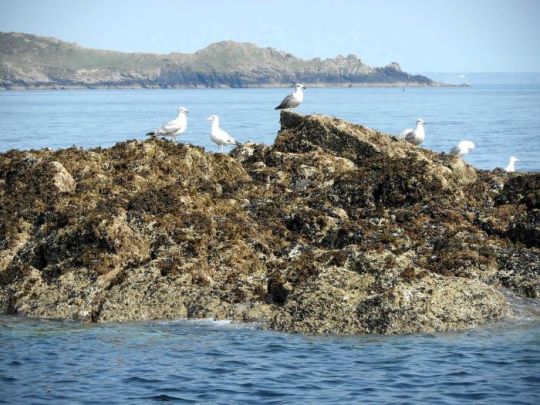
Auf dem Rückweg fahren wir an der kleinen Insel St. Clement vorbei, die nur 350 Meter vor dem Hafeneingang von Mousehole liegt.

Hier sonnen sich tatsächlich ein paar Kegelrobben auf den Steinen.

Die Kegelrobbe gehört wie der Seehund zur Familie der Hundsrobben (Phocidae).
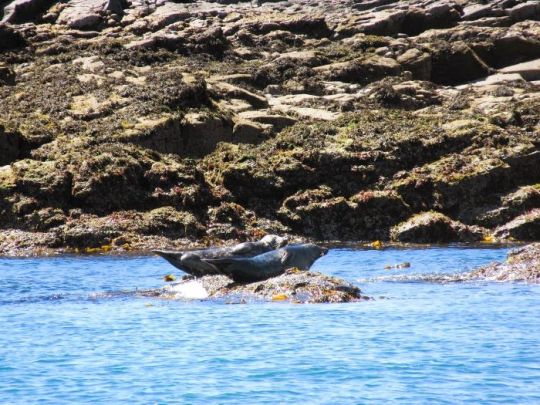
Die Tiere werden bis zu 2,50 Meter lang und erreichen ein Gewicht bis zu 300 Kilogramm.
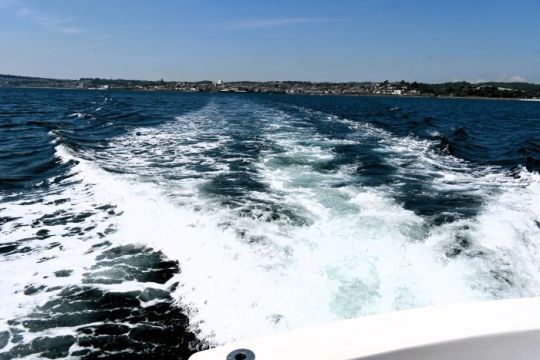
Ehe wir uns versehen, sind wir wieder im Hafen von Penzance angekommen. Schön war´s!
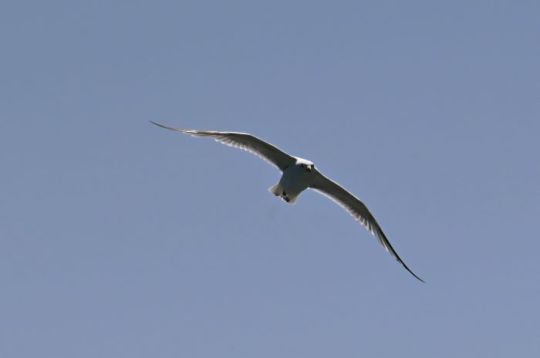
Anschließend schlendern wir noch durch Penzance bis hinunter an den Jubilee Pool. Ein Meerwasser-Strandbad im Art-Déco-Stil mit Blick auf das Meer.
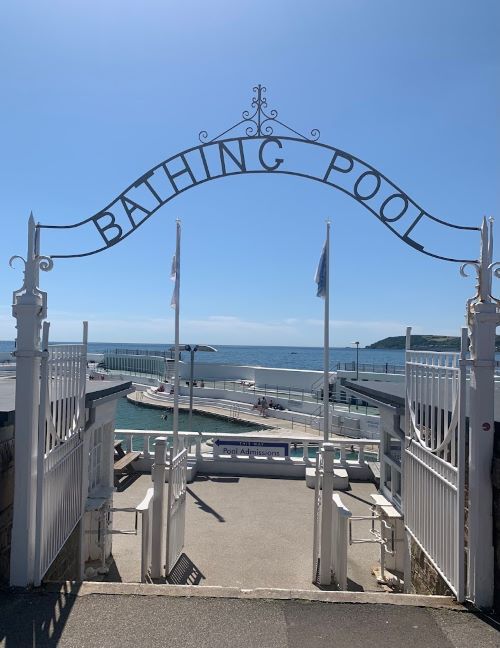
Das Lido wurde am 31. Mai 1935 im Rahmen der Feierlichkeiten zum Silberjubiläum von König Georg V. eröffnet. Es ist denkmalgeschützt und gilt, mit Ausnahme des Saltdean Lido bei Brighton, als das schönste erhaltene Beispiel seiner Art.

Während des Großteils des 20. Jahrhunderts spielten Strandbäder in vielen Küstenstädten eine große Rolle. Tatsächlich gab es einst bis zu 169 Strandbäder in ganz Großbritannien.
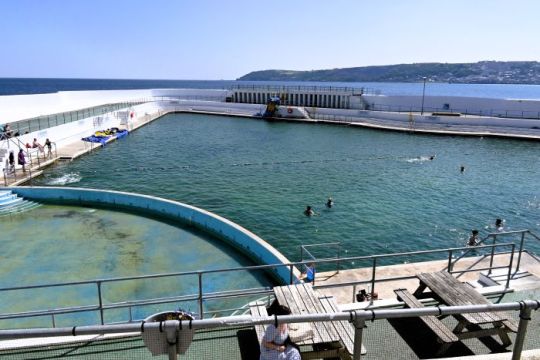
Der Jubilee Pool in Penzance ist der größte von nur noch fünf verbliebenen Meerwasser-Strandbädern im Vereinigten Königreich.
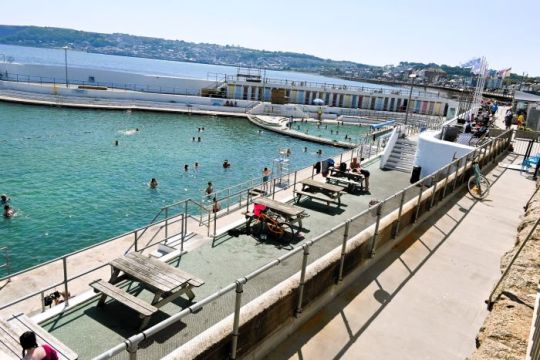
Heute beherbergt das Bad das erste geothermische Becken Großbritanniens, ein riesiges Schwimmbad und ein Anfängerbecken, die alle täglich mit frischem Meerwasser aufgefüllt werden.

Auf dem Rückweg zum Auto beobachten wir den Badespaß im Hafenbecken.

Der Sommer scheint offiziell für eröffnet erklärt.
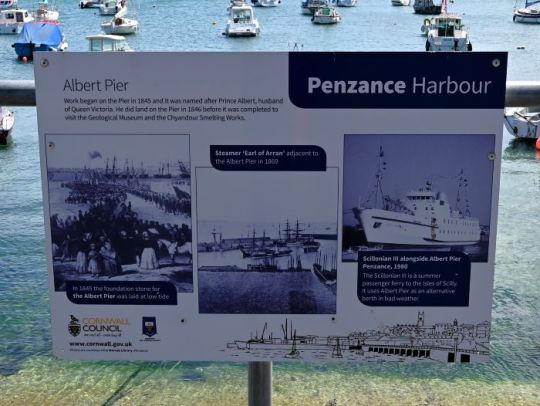
Die Außenplätze der Restaurants sind ebenfalls gut gefüllt.
Good Night!
Angie, Micha und Mister Bunnybear
6 notes
·
View notes
Text
A Thousand Miles of History XVIII: The path through the sea…
A Thousand Miles of History XVIII: The path through the sea…
The tide was still in when we reached Marazion, and yet a line of people snaked between the shore and the island half a mile into the sea, seemingly walking on water. We were going to join them, walking the old pilgrim route to St Michael’s Mount, one of the first points on the Michael Line, that runs from the westernmost tip of the land to its eastern shores.
The Mount rises from the sea…
View On WordPress
1 note
·
View note
Text
UK Day 10: Marazion and the Cornish Coast
UK Day 10: Marazion and the Cornish Coast

Posted August 16, 2019
[Note: I realize it’s taking me some time to get through these posts. Please bear with me. It’s been a hectic summer]
May 18, 2019
Continuing our travels along the south coast of England, we drove back through Cornwall and to the ancient village of Marazion [map]. Off shore on the island of Saint Michael’s Mount is a castle and church that can be visited by foot during low…
View On WordPress
4 notes
·
View notes
Text
Thursday Doors St Michael's Mount
Thursday Doors St Michael’s Mount
Two thousand years ago, traders sailed to an island off the coast of Cornwall from the Mediterranean to acquire tin. Then, it was known as Ictis. Following the Norman conquest, the monks of Mont Saint Michel took over the island to train novices at a newly-built priory, and renamed it St Michael’s Mount.
The fortified island can be reached by a causeway at low tide. It was bought after the Civil…

View On WordPress
1 note
·
View note
Text
The "Vita Sancta Keyna", an extract from the "Vita S. Cadoci", and a modern myth about the year 490 at St Michael's Mount
The “Vita Sancta Keyna”, an extract from the “Vita S. Cadoci”, and a modern myth about the year 490 at St Michael’s Mount
One of the Cornish saints was a woman. Her name was Saint Keyne, or Keyna – there are various spellings – and she is known from a number of hagiographical texts. She flourished in the late 5th century, and is connected to St Michael’s Mount. Indeed there are various places on the web that make claims such as:
Legends tell of a visit by St. Keyne and a spring that miraculously gushed forth…
View On WordPress
0 notes
Text
Poets of the Fess Hotel

Today, through a chain of associations called up by a book about alcoholic writers, and then by a volume of John Berryman’s best known work, I found myself ratcheted back to the year 1971, when I briefly entertained the delusion that I could write poetry. I was actively encouraged in this futile pursuit by a friend named John Tuschen, who cited Berryman as his favorite poet.
In ’71 I was living in Madison, Wisconsin, and had recently dropped out of the university there, after experiencing a drug-induced breakdown in late 1970 that led to several weeks in a psychiatric ward at the campus hospital.
After a brief period spent licking my wounds at my mother’s apartment outside Chicago, I returned to “Madtown,” where I immediately returned, unburdened by school work, to doing what I had been doing: drinking and using drugs, enthusiastically. The psychiatric care recommended by the hospital did not seem like a particularly useful option, and potentially an endless one, so I dropped my shrink after three sessions.
My style of therapy took place in the warm confines of the 602 Club, the campus-adjacent bar on University Avenue that I had begun to frequent before my lockdown adventure. This saloon had become a main hangout for the local bohemians in training. I’d started going there when I was working in the acting company of Broom Street Theater, the local experimental stage. In the theater’s early days, John Tuschen had started up “The Camel, The Lion, and The Child,” its in-house literary magazine. We had gotten to be friends, and we both like to drink, so I’d roll down to the bar after a day’s work as a stock boy in the small corner market one block up the street. (My apartment, which I briefly continued to share with two college friends, was also nearby; we served as custodians in the building, and the rent was cheap.)
Tuschen looked like your average hippie, with a skinny frame and long, straight, lank hair. He looked at the world sharply through a pair of rheumy, often red eyes. He had the vestiges of a childhood speech impediment, and the slight hitch of a stutter gave his poetry readings a unique rhythm. We’d sit together in the 602 night after night, kibitzing, arguing, and people-watching in the narrow, overheated room over the joint’s trademark drinks, big cold glass schooners of beer, which washed down cheap bottom-shelf shots. Alcohol was our bond.
Invariably Tuschen would pull some new thing he’d written out of his pocket. He was a poet in the big Ginsberg style, and in the days we were closest he was hammering away at a long “Howl”-like jeremiad about America called “Your Muther’s Eye.” We would often be joined by another aspiring poet who called himself Hannibal Plath, a sweet, angelic-looking guy who broke the heart of just about every woman who crossed his path, and sometimes by my new flame Connie, a statuesque redhead from St. Petersburg, Florida, who had me utterly in her thrall.
These were heady times, and you wound up getting swept away by them. I went back to working sporadically at Broom Street, which was charitably housed in St. Francis House, the youth Episcopal center a few blocks up the street from the 602. The theater began to mount irregular “Bacchanals” — free-form evenings of theatrical vignettes, poetry readings, music, and what-have-you. (Into the latter category fell a premiere slideshow screening of Michael Lesy’s remarkable photo-essay “Wisconsin Death Trip,” later a famous book drawn from newspaper clippings and hellish photos shot in the late 19th century in upstate Black River Falls, which unspooled at the theater over a long, dark John Fahey guitar piece.) Tuschen and some of the other Mad City poets were invariable fixtures of the events. My theater mentor, director Joel Gersmann, also read; he had written his own volume of what he called “junk poetry,” titled “Deep Shit.”
It was an anything-goes time, and, inspired by the company I was keeping, I started writing some poetry of my own. My stuff was never burdened by the larger demands of the form — it was free verse, unambitious self-expression, post-adolescent soul searching and bouquet-tossing love songs for my muse Connie (who was essentially my principal audience, if truth be told). My sense of rhythm was fair enough to keep the work aloft. Though it was little better than doggerel, Tuschen agreed to throw down the few bucks it cost to type up, lay out, and photocopy a couple hundred copies of a small book of my work, which I titled “Red Boots” (after my girlfriend’s favorite footwear) under his Quest Publishing rubric.
By mid-1971, I was chafing at my then-current living situation in a hippie pad off campus, where I witnessed the dramatic meltdown of one of my three roommates, a young, drug-crazed heiress we called “Spacey Gracie,” whose family had the police swoop in and drag her off to a private loony bin. Tuschen proposed that I move into an open room down the hall from his at the Fess Hotel.
Located at 123 E. Doty St., a block and a half away from the state capitol that served as the city’s hub, the Fess was something of a local landmark. A residential hotel that had opened in 1854, it had been operated by the Fess family for four generations; 69-year-old Alice Fess, the wife of the current owner, was the building’s truculent manager.
The place was then on the downward slope of its existence; at that point downtown Madison had gotten a little seedy, and it was surrounded by a number of bars and strip joints that catered to the state office workers and political lobbyists. Ironically, considering the amount of drinking that went on around and in the hotel in those days, one of the most famous Fess patrons in earlier times was the axe-wielding temperance crusader Carrie Nation. (Abraham Lincoln was said to have stayed there, but no one was ever able to confirm that for sure.) The place had a lobby where most hours you could find one of the older tenants dozing in a soiled chair or zoned out in front of an ancient TV set. Both the day desk clerk and the night clerk were walleyed, so communicating with the staff, who always seemed to be staring at something to your left, was a disconcerting experience.
I don’t think I paid more than $150 a month for a second-floor single at the Fess. Accommodations were unspectacular: The room contained an uncomfortable bed, a stained sink, a small closet, and a tiny, scarred desk in front of a window that looked out onto the grey street, where I tapped out my work on a turquoise Olivetti portable. I used the communal bathroom just outside my door, which was occupied competitively by the other tenants. Tuschen had a suite down the hall — he was the Fess pathfinder, after all — and Hannibal also had a room on my floor. For obvious reasons, Tuschen’s spacious room became the focal point for a considerable amount of drinking among the three resident versifiers, all of us living out our Beat Generation fantasies.
A couple of times, the university’s visiting professor of creative writing entered into this fantastical den, and he made his presence forcefully known. His name was George Barker. Though he is little known or remembered in America today, Barker was one of England’s great poetry prodigies of the 1930s. He was T.S. Eliot’s protégé, and William Butler Yeats was an admirer.
At 58, he was gaunt and lined; he was suitably dressed in tweeds, and displayed the waspish, razor-tongued manner of the old-school British intelligentsia. He was accompanied by a smart, auburn-haired, very beautiful young woman he introduced as his wife. But we did not know that Elspeth Langlands was not yet George Barker’s wife — his spouse Jessica, a Roman Catholic, refused to grant him a divorce. Elspeth had been introduced to Barker, who was 27 years her senior, when she was 22 by Barker’s longtime mistress Elizabeth Smart, who had tired of the poet’s violent, alcohol-fueled behavior (which she, an alcoholic and drug addict herself, had chronicled in a 1945 novel in verse, “By Grand Central Station I Sat Down and Wept”) and happily handed him off to a new partner.
Barker would huddle with Elspeth on the floor of Tuschen’s flat with a gallon glass jug of Annie Green Springs, the sickeningly sweet, cheap party wine, at his side. He would get hammered on the foul stuff, which was manufactured purely for effect, all night long, as he diced up the manuscripts that Tuschen and Hannibal would read aloud for him. The work of these young writers could not have been further from the well-manicured “New Apocalyptic” writing that had won him kudos three decades ago, and he had little patience with it.
I never had the temerity, or the courage, to try out my jejune material on him, but one evening I made the mistake of reading Frank O’Hara’s “The Day Lady Died,” the New York poet’s shocked, moving reaction to Billie Holiday’s tragic demise.
After I finished, he paused for a beat and said, “Dear boy, that’s pure shit.”
That cold dismissal of a writer I love essentially ended my poetic aspirations for good.
“Red Boots” was published in early 1972, and sold tepidly at the Madison Book Co-op, the hip book outlet that became Bukowski’s local sponsor. While I was already re-enrolled at the University of Wisconsin, I managed to get a chance to live out a couple of my poetry fantasies before I hung up my spurs for good. The school actually hired me to give a reading on campus; I was paired with Bob Watt, the snaggle-toothed, lecherous pest exterminator/folk artist/“art” photographer who was a local legend in Milwaukee. Incredibly, Tuschen also convinced the university library to purchase copies of the entire Quest catalog, and so today “Red Boots” resides in the UW’s rare books collection. (I do not anticipate any scholarly interest — it’s truly dreadful.) After my father died in 2002, I learned with amazement that he kept a copy of the book — which contained a poem about our strained relationship — in his office desk.
Mrs. Fess learned from her clerks that Connie had been stretching herself across my narrow hotel bed, so I was politely asked to vacate the premises of her none too clean but nonetheless respectable establishment, and I moved into my girl’s pad on Fraternity Row. The Fess, which became a popular downtown restaurant for 20 years after the family sold it in 1975, is still operating today as a gastropub. The building was added to the National Register of Historic Places in 1978.
We all went our separate ways. John Tuschen, who had titled one of his book “The Percodan Papers” after a favorite intoxicant, quit drugs and alcohol and became a drug rehabilitation counselor. In 1977, he was named the first poet laureate of Madison. He died in 2005; his longtime companion Suni asked me if she could reprint an honest but unflattering poem about him for a memorial volume, and of course I said yes, despite my misgivings about its quality. Hannibal left town, became a minister, and wrote a couple of spiritually themed self-help books. George Barker died at 78 in 1991, two years after he finally married Elspeth following the death of his wife. Elspeth Barker died at 81 in April of this year. A respected journalist, essayist, and novelist, she bore four of Barker’s 15 children.
Connie and I split up, then regrouped in Chicago, where we took root in a new bar on Lincoln Avenue. I began a protracted sidelong course to becoming a working journalist. I would learn that it was easier for me to write about what was in front of my eyes and ears than it was to chart the course of my heart. That great gift belongs to others.
3 notes
·
View notes
Photo

Evening off St Michael's Mount, 1855, James Webb
https://www.wikiart.org/en/james-webb/evening-off-st-michael-s-mount-1855
36 notes
·
View notes